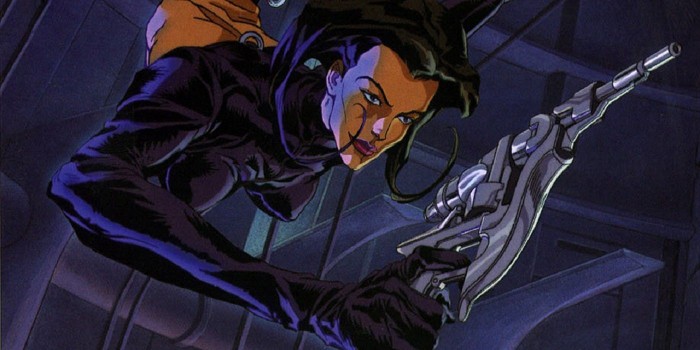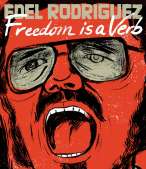
A modern television show in development has many hurdles to overcome before any network will give it the green light. With censorship, advocacy groups, fickle viewership and production costs all at play, it is fair to say that the majority of television productions are scrapped before they see the light of day. Fortunately, these obstacles did not impede the birth of the enigmatic Aeon Flux by Peter Chung.
The show takes place in a cyberpunk-styled dystopian setting. Its story follows the movements of the female assassin/insurgent, Aeon Flux as she attempts to outwit and overthrow her nemesis and lover, Trevor Goodchild. She, a spy from the anarchist society of Monica, is represented in borderline fetish fashions and leather gear. Goodchild is the authoritarian dictator of the adjacent city-state of Bregna. He uses citizens as scientific test subjects and is under constant threat of Aeon’s political plots and allure.

At no point in the show is it made clear which one is the protagonist and which is the villain. Chung’s aim, from the very beginning, was to uphold ethical ambiguity in order to inspire questioning thoughts in the viewer – questions which would remain unanswered conundrums. Aeon Flux is not concerned with continuity either, as the titular character suffers a violent death in several individual episodes only to emerge unscathed in the following one. Surreal themes of self-imposed amnesia, artificial intelligence and eroticism fuel episode plotlines.
Aesthetically, Chung draws a stark view of anti-heroes. The characters of Aeon Flux are cadaverous and angular as opposed to the svelt muscularity of popular vigilantes such as Superman and Wonder Woman. Characters are drawn with razor sharp skeletal features and gravity-defying hairstyles. The acrobatic anatomy of Aeon, who always sports a dominatrix-inspired outfit, is presented with clear sexuality. Chung does not don kid gloves in the portrayal of violence and physical combat either.
In a more psychological sense, Aeon Flux provides a progressive view of sex positivity and gender identity. To match her scant leather attire, the character of Aeon displays unapologetic promiscuity and kink throughout. One particular episode highlights the argument between Aeon and Trevor regarding the gender of an alien who is without biological assignation. Another scene is based on the pregnancy of a male citizen.
Speaking to Former People, Chung explains the non-declarative nature of Aeon Flux.
“I do find that when I am watching the films or reading the books that I enjoy my mind starts to get evoked into a thought process that is different… it takes you out of your ordinary, mundane way of thinking. It is kind of a cliché but it is mind altering… it expands your consciousness … and that is why I think that I am more interested in the process of thinking that gets evoked through looking at my work than providing any kind of answers.
If you are involved in a process of trying to figure out what is happening, what you are witnessing on the screen, then your mind is encouraged to go to places it wouldn’t ordinarily go to, and I am satisfied with that.”

The Korean American started his animation career in 1980 at a small creative firm in Maryland having recently graduated from the California Institute of the Arts. At the age of 19, he worked under the guidance of illustrator Salvador Bru and designed characters for Hanna-Barbera Cartoons. He was soon drafted by Disney to work on live-action feature projects. During the early stages of his career, the idea behind Aeon Flux started to flourish as a response, in Chung’s mind, to the clichés of superhero depiction in 1980s Hollywood cinema.
A pivotal point came in 1990 with Chung’s involvement with the popular children’s show, Rugrats. He collaborated with Gábor Csupó and Arlene Klasky to design and develop characters for the cartoon show. Chung storyboarded the show’s plot as well as the opening sequence of Rugrats.
Despite the positive reaction and popularity that followed the children’s show, Chung felt that the constraints that came with a children’s production were too creatively binding. In order to keep Rugrats’ appeal open to actual toddlers, character development and storyline advancement was practically non-existent.
From this bottle-neck of creative confinement came Aeon Flux. In its first iteration, the science fiction-based animation was a series of 6 short films that aired as part of MTV’s Liquid Television in 1991. The following year, 5 individual short episodes were produced and in 1995 a fully fledged season of 10 half-hour episodes aired as an independent series.

Chung had created a show that features adult themes as part of its aesthetic style as well as its episodical story archs. Animated content of a mature nature that is unrelated to comedy seldom survive past development phase.
For a show that was first aired over 25 years ago, Aeon Flux remains a potent distillation of cyberpunk culture and is a salient example of evocative adult-themed animation. The variables that make Aeon Flux bizarre, especially considering entertainment norms of the early 1990s, cements its uniqueness as a fringe-animation show.







